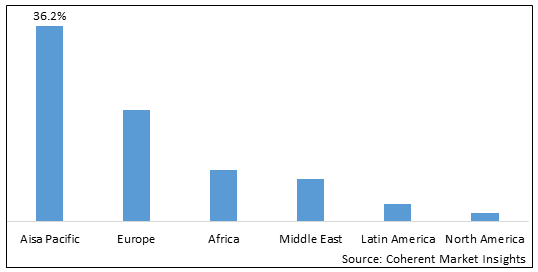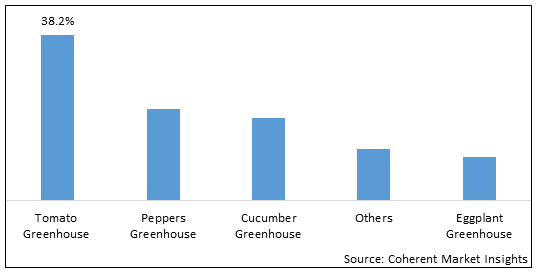High End Greenhouse Market is estimated to be valued at USD 1,971.0 Mn in 2025 and is expected to reach USD 2,810.6 Mn in 2032, exhibiting a compound annual growth rate (CAGR) of 5.2% from 2025 to 2032. High end greenhouses are greenhouses that are installed with devices to control temperature, moisture, humidity, and other environmental parameters. These devices help greenhouses to grow crops faster, more sustainably, and in almost every external condition. High-end greenhouses frequently provide ideal plant development conditions while maximizing energy efficiency. To maintain constant temperatures and humidity levels, they may include features such as insulated glass, energy-efficient heating and cooling systems, and improved ventilation systems. Furthermore, high-end greenhouses may feature innovative technologies including remote monitoring and control systems, which allow growers to remotely monitor and change greenhouse conditions. These characteristics promote optimal plant development, boost production, and decrease labor needs. High-end greenhouses are ideal for commercial-scale plant production, research facilities, and other applications where precise control over environmental factors is critical for optimal plant growth and productivity due to the use of high-quality materials, advanced technology, and precision control systems.
High End Greenhouse Market - Impact of Coronavirus (COVID-19) Pandemic
The coronavirus (COVID-19) pandemic has had a deep impact on economies across the globe, and businesses incurred substantial losses in 2020. As numerous countries were still under lockdown in 2021, global expenditure on numerous products reduced substantially. Organic farm products cost higher than conventionally farmed products. With deteriorating economic conditions in many countries due to the pandemic, the overall expenditure on expensive organic products is declining. For instance, in 2021, the rise in fuel prices led to the inflation in the India. Such factors have led to the decline of premium greenhouse products in the global high end greenhouse market.
High End Greenhouse Market: Growth Drivers
The growing demand for agricultural products
Growth in the population is expected to drive the demand for agricultural food products. In addition to the growing population, economic development in emerging economies will further drive the demand for agricultural products. For instance, according to Indian Ministry of Commerce & Industry, India’s agri exports crossed USD 50 billion for the year 2021-22 and it created matrix for 50 agricultural products with good export potential to help boost agri exports. Such factors are expected to drive the demand for agricultural products and subsequently drives the demand for high end greenhouses, as an increasing number of farmers are focusing on the use of modern technologies to increase harvest. Furthermore, greenhouse allows farmers to grow a range of crops throughout the year, even during the winter season when the intensity of sunlight received is low.
High End Greenhouse Market: Market Restraints
Lower durability of parts produced by additive manufacturing
High initial investments required to setup a high end greenhouse is expected to hamper the market growth over the forecast period. Greenhouses trap sunlight to provide crops a longer growing period. Plastic films used in greenhouses can lead to the excessive heating of greenhouses during the summer season (if temperature levels exceed the healthy levels and proper ventilation systems are not in place to control the temperature). Glass windows are the most effective material used for maintaining heat in a greenhouse and also allows the greenhouse to be ventilated when required. However, these are much costlier than plastic film alternatives. Even though glass has a longer life in greenhouse than its alternatives, their material and installation costs are much higher in comparison to their alternatives. There are, however, viable alternatives to offset the hefty initial expenditure necessary for a high-end greenhouse. To begin with, there is an increasing tendency towards government subsidies and grants to assist offset expenditures. Secondly, technological and material developments are consistently lowering the overall cost of greenhouse building. Finally, the long-term advantages of a high-end greenhouse, such as improved crop yields and longer growing seasons, can deliver a significant return on investment over time.
High End Greenhouse Market Report Coverage
| Report Coverage | Details | ||
|---|---|---|---|
| Base Year: | 2024 | Market Size in 2025: | USD 1,971.0 Mn |
| Historical Data for: | 2020 To 2024 | Forecast Period: | 2025 To 2032 |
| Forecast Period 2025 to 2032 CAGR: | 5.2% | 2032 Value Projection: | USD 2,810.6 Mn |
| Geographies covered: |
|
||
| Segments covered: |
|
||
| Companies covered: |
Texas Greenhouse Company Inc., Nexus Corporation, Certhon, Dutch Greenhouse, Conley's Manufacturing and Sales, Netafim, The Toro Company, Nelson Irrigation, LumiGrow, Poly-Tex, Inc., United Greenhouse Systems, Inc., CMF Groupe, China Agrotime, Artigianfer srl, Atlas Manufacturing Inc., Rough Brothers, Inc., Ludy Greenhouse Manufacturing Corporation, Stuppy Greenhouse, The BARRE Company, Asthor Greenhouse Manufacturer, Ammerlaan Construction, Greenhouse Kenya Company, Grekkon Limited, Illuminum Greenhouse, Haygrove Limited, Sunmax Greenhouse, GGS Structures Inc., Rimol Greenhouse Systems, Idroterm Serre Srl, and MSC Invernaderos |
||
| Growth Drivers: |
|
||
| Restraints & Challenges: |
|
||
Uncover macros and micros vetted on 75+ parameters: Get instant access to report
Market Trends
The increasing demand for organic and localized agricultural products
The increasing demand for organic and localized agricultural products is expected to drive the demand for high end greenhouses. Locally produced vegetables and fruits spend the least time period between harvest and consumption, and this substantially keeps the nutritional value of the product intact. Furthermore, locally produced food also reduces the transportation cost, product cost, and also supports the local economy. According to data from the World Association of Chefs Society, locally produced organic products also tend to taste better than products imported from other regions. For instance, according to U.S. Department Of Agriculture, National Agricultural Statistics Service surveys (2011 and 2021): Certified organic cropland acres increased by 79 percent (to 3.6 million acres), pastureland/rangeland decreased by 22 percent (to 1.3 million acres), and certified operations increased by more than 90 percent (to 17,445 farms) over the 2011–21 period.
High End Greenhouse Market: Regional Analysis
Among regions, Asia Pacific held the dominant position in the global high end greenhouse market in 2025, accounting for 45.9% of the market share in terms of revenue, followed by Europe and Africa. Increasing number of high tech greenhouses in the region are expected to boost the growth of the market. The number of high-tech greenhouses in Asia Pacific has increased, which is likely to enhance the market growth. The growing use of innovative technologies such as automation, climate control systems, and LED lighting, have aided in the improvement of crop quality and output throughout Asia Pacific. Furthermore, the region's favorable climatic conditions and growing emphasis on sustainable agriculture practices have aided the expansion of the high end greenhouse sector. Europe is falling behind Asia Pacific in terms of market share, owing to developments in horticultural technology and the rising demand for quality crop output annually. Africa also captures a substantial part of the high end greenhouse market owing to favorable government efforts, expanding greenhouse farming investments, and the need for food security in the region.
Figure 1. Global High End Greenhouse Market Revenue Share (%), By Region, 2025

To learn more about this report, Download Free Sample
High End Greenhouse Market: Segmentation
On the basis of product type, in 2025, the tomato greenhouse segment accounted for 38.2% of the revenue share. The increasing adoption of hydroponic technology for the production of tomatoes, to curtail the usage of soil for the growth of plants, is expected to drive the segment growth. Greenhouse-grown tomatoes have increased in popularity due to the several benefits they provide in terms of quality and quantity. Tomatoes may be grown in a controlled setting using Hydroponic technology, which provides ideal growing circumstances. When compared to traditional agricultural practices, this strategy ensures a larger output and higher-quality product. The growing consumer knowledge of the benefits of organic and locally grown products can be related to the increased demand for greenhouse-grown tomatoes. Greenhouse tomatoes are said to be healthier and safer because they do not contain pesticides or genetically modified organisms. Furthermore, greenhouse settings allow for year-round production, removing traditional farming's seasonal constraints. This allows consumers to have access to fresh tomatoes all year round, contributing to the strong demand. Demand is also driven by greenhouse-grown tomatoes' greater taste, texture, and appearance. These features, together with the ease of use of hydroponic technology, make greenhouses a profitable investment for both farmers and investors. Overall, the tomato greenhouse segment's revenue share demonstrates the effectiveness and promise of hydroponic technology in addressing the growing demand for high-quality, locally grown tomatoes. This trend is projected to continue as customers choose healthier and more environment-friendly food alternatives.
Figure 2. Global High End Greenhouse Market Revenue Share (%), By Product Type, 2025

To learn more about this report, Download Free Sample
High End Greenhouse Market: Key Developments
High End Greenhouse Market: Key Companies
The major players operating in the market include Texas Greenhouse Company Inc., Nexus Corporation, Certhon, Dutch Greenhouse, Conley's Manufacturing and Sales, Netafim, The Toro Company, Nelson Irrigation, LumiGrow, Poly-Tex, Inc., United Greenhouse Systems, Inc., CMF Groupe, China Agrotime, Artigianfer srl, Atlas Manufacturing Inc., Rough Brothers, Inc., Ludy Greenhouse Manufacturing Corporation, Stuppy Greenhouse, The BARRE Company, Asthor Greenhouse Manufacturer, Ammerlaan Construction, Greenhouse Kenya Company, Grekkon Limited, Illuminum Greenhouse, Haygrove Limited, Sunmax Greenhouse, GGS Structures Inc., Rimol Greenhouse Systems, Idroterm Serre Srl, and MSC Invernaderos.
*Definition: A high-end greenhouse is a cutting-edge, technologically advanced building used for plant growing and protection in a controlled environment. These greenhouses are often built with high-quality materials and include modern features such as automated climate control systems, precision irrigation systems, energy-efficient lighting systems, and advanced pest and disease control techniques.
Share
Share
About Author
Yash Doshi is a Senior Management Consultant. He has 12+ years of experience in conducting research and handling consulting projects across verticals in APAC, EMEA, and the Americas.
He brings strong acumen in helping chemical companies navigate complex challenges and identify growth opportunities. He has deep expertise across the chemicals value chain, including commodity, specialty and fine chemicals, plastics and polymers, and petrochemicals. Yash is a sought-after speaker at industry conferences and contributes to various publications on topics related commodity, specialty and fine chemicals, plastics and polymers, and petrochemicals.
Missing comfort of reading report in your local language? Find your preferred language :
Transform your Strategy with Exclusive Trending Reports :
Frequently Asked Questions
Select a License Type
Joining thousands of companies around the world committed to making the Excellent Business Solutions.
View All Our Clients